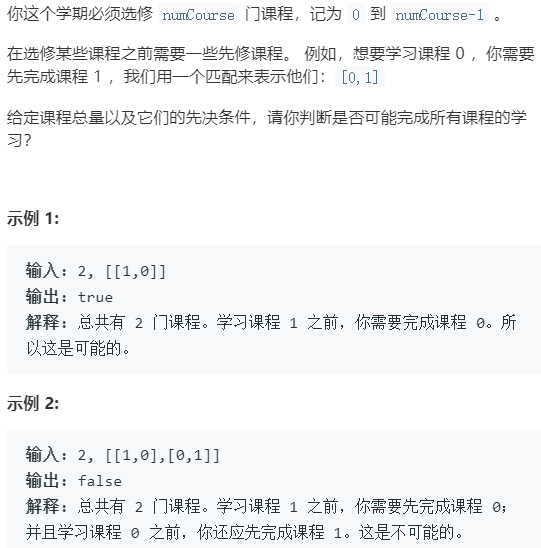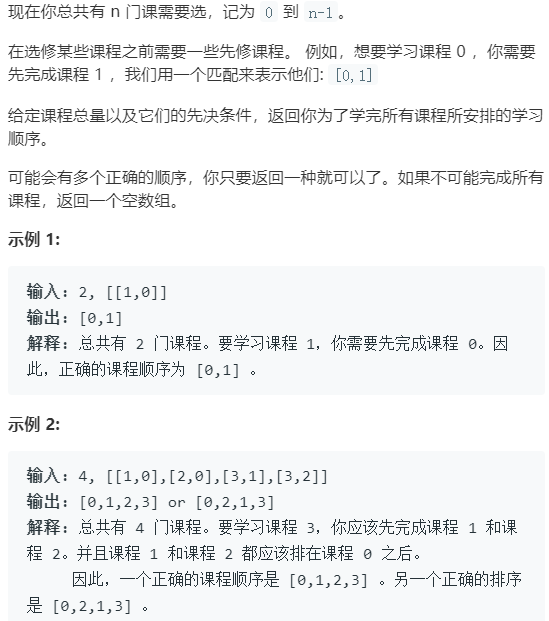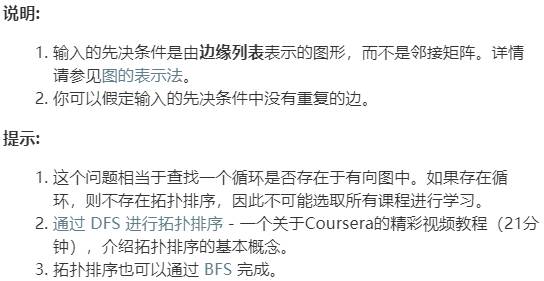NO.207 课程表 中等 、NO.210 课程表 II 中等
非常经典的拓扑排序问题
NO.207 课程表 中等


思路一:拓扑排序 拓扑排序的总体思路选择 广度优先遍历+贪心 。
通常拓扑排序有两个主要功能:
- 得到一条拓扑序列,拓扑序列不唯一。
- 判断一个有向图是否有环。
实现上,用两个集合,分别保存每个节点入度的数量、每个节点的下一个后继节点。还需要一个队列,进行广度优先遍历。
将没有前驱的节点(入度为 0 )入队,广搜每出队一个节点,就将该节点的所有后继邻接节点的入度 -1 ,如果入度减为 0(没有前驱节点) 则节点入队。
广搜过程中记录出队节点的数量 count,如果图中有环,则 count<numCourses 。
1
2
3
4
5
6
7
8
9
10
11
12
13
14
15
16
17
18
19
20
21
22
23
24
25
26
27
28
29
30
31
32
33
34
35
36
37
38
| public boolean canFinish(int numCourses, int[][] prerequisites) {
if (prerequisites.length == 0) return true;
int[] inDegree = new int[numCourses];
HashSet<Integer>[] nextAdjacency = new HashSet[numCourses];
for (int i = 0; i < numCourses; i++) nextAdjacency[i] = new HashSet<>();
for (int[] temp : prerequisites) {
inDegree[temp[0]]++;
nextAdjacency[temp[1]].add(temp[0]);
}
Queue<Integer> queue = new LinkedList<>();
for (int i = 0; i < inDegree.length; i++) {
if (inDegree[i] == 0) {
queue.offer(i);
}
}
int count = 0;
while (!queue.isEmpty()) {
Integer poll = queue.poll();
count++;
for (int next : nextAdjacency[poll]) {
inDegree[next]--;
if (inDegree[next] == 0) {
queue.offer(next);
}
}
}
return count == numCourses;
}
|
时间复杂度:O(E+V) 边的数量 E ,节点数量 V。两次遍历邻接表
空间复杂度:O(E+V)
NO.210 课程表 II 中等


相较于前一题,本题需要返回一条拓扑排序的路径。
思路一:拓扑排序 和上一题的思路一样,区别在于本题需要记录出队的节点序列,而不仅仅是数量。
1
2
3
4
5
6
7
8
9
10
11
12
13
14
15
16
17
18
19
20
21
22
23
24
25
26
27
28
29
30
31
32
33
34
35
36
37
38
39
| public int[] findOrder(int numCourses, int[][] prerequisites) {
int[] inDegree = new int[numCourses];
List<Integer>[] nextAdjacency = new List[numCourses];
for (int i = 0; i < numCourses; i++) nextAdjacency[i] = new LinkedList<>();
for (int[] temp : prerequisites) {
inDegree[temp[0]]++;
nextAdjacency[temp[1]].add(temp[0]);
}
Queue<Integer> queue = new LinkedList<>();
for (int i = 0; i < inDegree.length; i++) {
if (inDegree[i] == 0) {
queue.offer(i);
}
}
int[] res = new int[numCourses];
int count = 0;
while (!queue.isEmpty()) {
int poll = queue.poll();
res[count++] = poll;
for (int next : nextAdjacency[poll]) {
inDegree[next]--;
if (inDegree[next] == 0) {
queue.offer(next);
}
}
}
return count == numCourses ? res : new int[0];
}
|
时间复杂度:O(E+V) 边的数量 E ,节点数量 V。两次遍历邻接表
空间复杂度:O(E+V)
本人菜鸟,有错误请告知,感激不尽!
更多题解和源码:github



